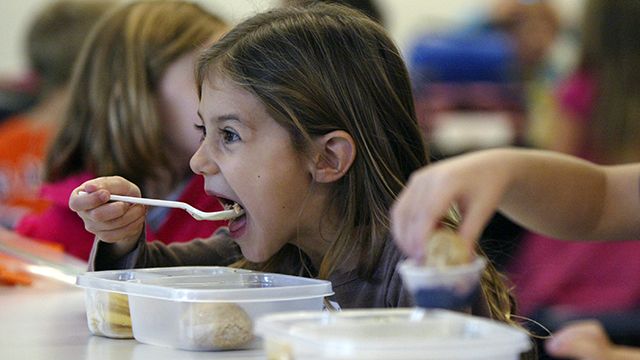This post is cross-posted on TalkPoverty.org, a new blog launched by former Moyers & Company guest Greg Kaufmann.

In recent weeks, both House and Senate Appropriations Committees advanced 2015 Agriculture appropriations bills, taking the opportunity to meddle counterproductively in USDA child nutrition policies. Most visibly, the House version of the bill weakens the current science-based nutrition standards for both school meals and WIC — permitting schools to opt-out of the meal standards enacted in 2010, and allowing white potatoes in the WIC package. First Lady Michelle Obama is a leading champion of the current standards, and recently expressed her dismay with the House bill in The New York Times.
The House bill also restricts funding for a summer food pilot program to rural counties in Appalachia. While this language would not, as some media reports have erroneously implied, end all summer meals programs for children in cities, it is still troubling.
The pilot program in question is the Summer Electronic Benefits Transfer for Children (SEBTC), which the USDA initially piloted in 2011 as an alternative approach to providing food assistance to children during the summer. It was designed to address a major barrier in the current Summer Food Service Program (SFSP) — namely, that children must eat meals onsite at community locations. For families with limited access to transportation, and for parents who work, taking children to a meal site in the middle of the day can be a challenge. Instead, SEBTC provides low-income families with an Electronic Benefits Transfer card (like a pre-paid debit card) that contains $60 per child per month — about the same amount the federal government spends per child on school meals — that can be used to buy groceries.
In its first two years, SEBTC was tested in rural and urban areas in eight states and two tribal nations in different regions of the US, and was effective in reducing child hunger. Nine out of ten families issued SEBTC benefits used them, and the program eliminated very low food security for one-third of the children who would otherwise have experienced it. Children in participating households also ate more fruits, vegetables and whole grains, and drank fewer sugary beverages. And with increasing child hunger during the summer when school’s out, but stubbornly low participation in SFSP nationally, it is promising that USDA is testing innovative strategies that work in communities across the country — urban, suburban and rural. These results are so promising that Senator Patty Murray (D-WA) is sponsoring the Stop Child Summer Hunger Act, which would expand SEBTC nationwide beginning in 2016.
While the House Appropriations bill would leave intact the larger summer meals program in urban, rural and suburban areas, it would limit the successful SEBTC pilot program only to Appalachian counties. That would mean the program would reach only a fraction of children living in poverty and experiencing food insecurity across the country, and it would also have deeply racialized outcomes — primarily benefiting white children. It is true that Appalachia has high rates of poverty and has for generations. However, only 7 of the 50 counties with the highest child poverty rates in the nation are in Appalachia; most of the others are in the Mississippi Delta and neighboring areas in Alabama and Georgia. And the counties with the largest numbers of children living in poverty are urban. In fact, pilot programs in just four counties — Los Angeles County, California; Harris County, Texas (Houston); Cook County, Illinois (Chicago); and Maricopa County, Arizona (Phoenix) — would reach more children below the poverty line than pilot programs in all 418 Appalachian counties.
Likewise, limiting SEBTC to Appalachia in essence restricts participation in the program to majority white communities, excluding counties — both urban and rural — with high percentages of people of color. The Appalachian Regional Commission reports that Appalachia is 83.5 percent white, a much larger majority than the country overall, which is 63.7 percent white. Additionally, only 13 of the 50 counties with the highest child poverty rates are majority white — though 49 of those counties are rural. MSNBC reported earlier this year that the county with the highest overall food insecurity in the nation (Humphreys County, Mississippi), and the one with the highest child food insecurity in the nation (Zavala County, Texas), are similar in a few ways: “Both are in poor, rural areas of the South [and] have socially and economically isolated populations.” They are both majority people of color, as well. But they are not in Appalachia.
These facts are not surprising when you consider how poverty disproportionately impacts people of color in both urban and rural areas. The national poverty rate is 14.3 percent; however, nearly one in four people who identify as Native American, black or Latino live below the poverty line. The poverty rate for whites, on the other hand, is well below that of other racial groups and the nation overall, at 9.9 percent.
Geography, poverty and race intersect in the US in profound ways, and have for centuries, due to countless policies that have restricted access to economic and geographic resources by race. With its current proposal, the House continues the common practice of building policies that perpetuate racial inequities without actually naming race. If we want to ensure that all hungry children are fed — and all families have access to the most convenient and effective ways of feeding their children — then we have to make sure that our policies are truly inclusive of every child, considering both where they live and their racial identity.
Ending child hunger and ending racial inequities are not mutually exclusive. They must go hand in hand.



